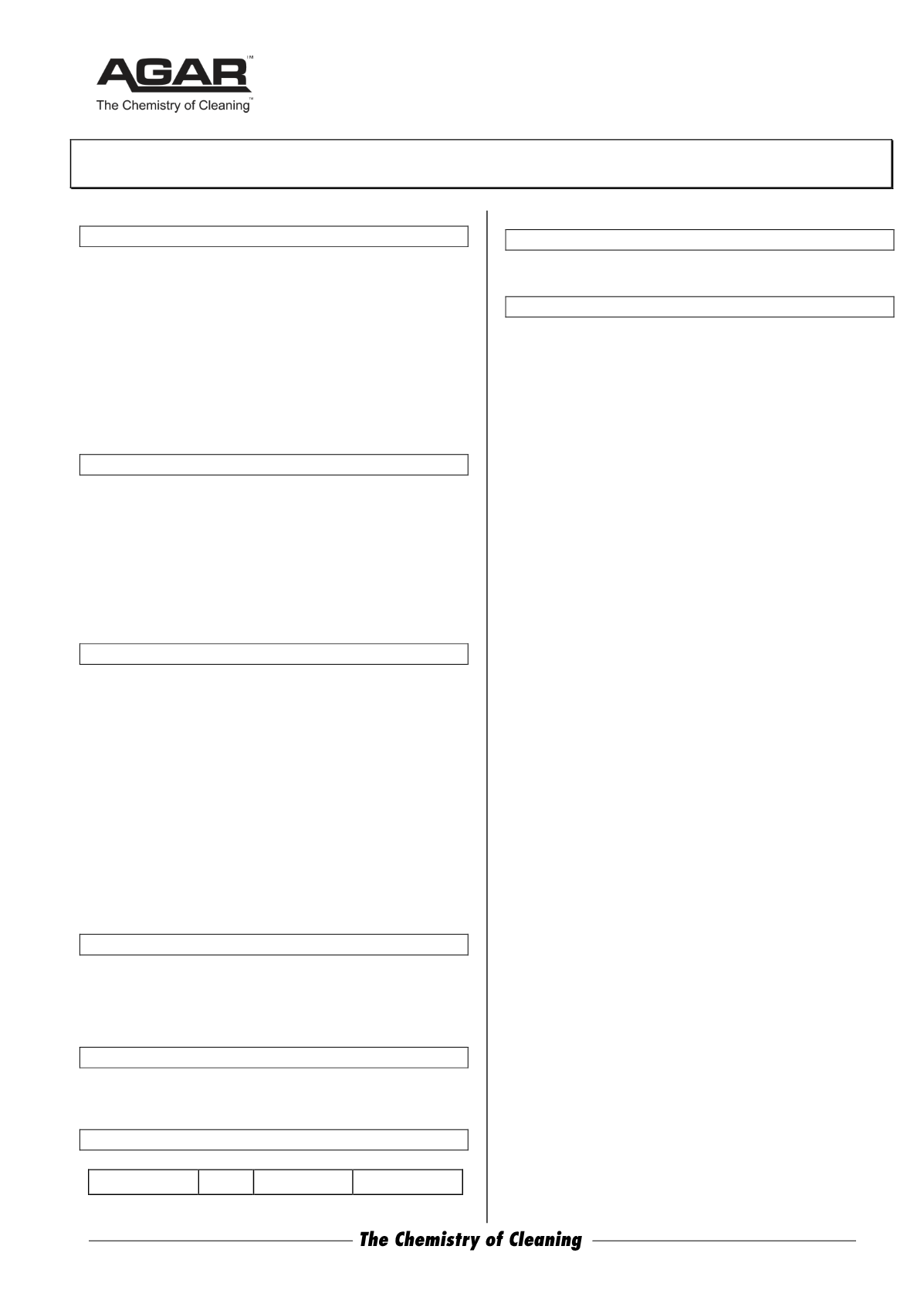

ABN 80 004 726 890 | MADE IN AUSTRALIA
Safety Data Sheet
Issued: March 26, 2014
Page 2 of 2
GALLEY 2
9 PHYSICAL AND CHEMICAL PROPERTIES
Appearance: White powder
Odour: Faint chlorine odour
pH = 12-13 (at 1% in water)
Vapour Pressure: N/K
Vapour Density: N/K
Boiling Point: -
Freezing Point: < 0
°
C
Solubility in water: Soluble
Specific Gravity : -
Evaporation rate: N/A
% Volatile by vol: < 1%
10 STABILITY AND REACTIVITY
Stable.
Do not mix with acids as this may generate toxic chlorine gas.
Do not store in aluminium or galvanised containers. Store away
from acids. Galley 2 is a caustic product which attacks soft
metals.
Hazardous polymerization: None.
11 TOXICOLOGICAL INFORMATION
Health Effects:
Acute -
Swallowed:
Because of its high alkalinity in the undiluted state,
Galley 2 is corrosive to the gastro-intestinal tract if
swallowed.
Eye:
Corrosive to the eyes. May cause corneal burns.
Skin:
Principal route of exposure is usually by skin contact.
Irritating to the skin on contact.
Inhalation:
Risk is low if product is used as directed, but
breathing of dust or vapour should be avoided.
Health Effects -
Chronic
: Repeated or prolonged skin contact
may cause burns.
Toxicity data: Not available for mixture.
12 ECOLOGICAL INFORMATION
Ecotoxicity: No data available.
Persistence and degradability: -
Mobility: -
Advice: -
13 DISPOSAL CONSIDERATIONS
For disposal, refer to State Land Waste Management authority.
14 TRANSPORT INFORMATION
UN No.: - not reg Class: - Packg.Group: -
Hazchem: -
15 REGULATORY INFORMATION
Poisons Schedule Number: Schedule 5.
16 OTHER INFORMATION
AICS Listing:
All components of Galley 2 are listed on the
Australian Inventory of Chemical Substances (AICS).
Date: This SDS issued on March 26, 2014 shall remain valid
for 5 years unless a new SDS is issued in the meantime.
Please contact Agar Cleaning Systems P/L to ensure you have
the latest version of this product’s SDS.
Abbreviations and Definitions of terms used:
<
less than
>
greater than
AICS
Australian Inventory of Chemical
Substances
CAS
Chemical Abstracts Service (Registry
Number)
COD Chemical Oxygen Demand
deg C Degrees Celsius
g
gram
g/L grams per litre
HSIS
Hazardous Substance Information System
kg
kilogram
L
Litre
LC50
The concentration of a material (inhaled)
that will be lethal to 50% of the test animals.
LD50
The dose (swallowed all at once) which is
lethal to 50% of a group of test animals.
m3
Cubic metre
mg
milligram
mg/m3 milligrams per cubic metre
miscible A liquid that mixes homogeneously with
another liquid
N/A
Not applicable
N/K
Not Known
NIOSH
National Institute for Occupational Safety
and Health
non-haz Non- hazardous
PEL
Permissible Exposure Limit
ppb
Parts per billion
ppm Parts per million
STEL Short term exposure limit
TLV
Threshold Limit Value
TWA
Time Weighted average
UN
United Nations (Number)
wt
weight
The information in this Data Sheet is based on our present
knowledge. However, this shall not constitute a guarantee for
any specific product features and shall not establish a legally
valid contractual relationship. Agar Cleaning Systems accepts
no tortious or contractual liability for any loss or damages
suffered as a consequence of reliance on the information and
advice contained herein.
End of SDS.


















